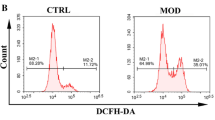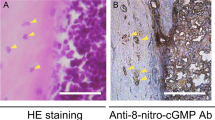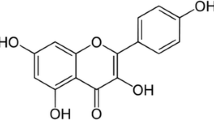Abstract
Angiotensin II (Ang II) has been shown to induce receptor activator of nuclear factor-κB ligand (RANKL) expression in osteoblasts associated with its effect on reactive oxygen species (ROS) production. The objective of the present study was to investigate the potential pathways by which Ang II induces RANKL expression and the role of ROS in Ang II-induced RANKL expression in mouse osteoblastic MC3T3-E1 cells. Treatment with Ang IIinduced RANKL expression in a dose- and time-dependent manner in osteoblasts, which was attenuated by pre-treatment with an AT1 receptor antagonist (olmesartan), ROS scavenger (N-acetylcysteine, NAC), or the ERK inhibitor (U0126), but not with AT2R antagonist (PD123319). Furthermore, Ang II enhanced AT1R and NAD(P)H oxidase (NOX) p22phox and p67phox expression and activity in osteoblasts. In addition, Ang II promoted ROS production, which was mitigated by pre-treatment with olmesartan or a NOX inhibitor (diphenyleneiodonium, DPI), but not with PD1123319 or U0126, in osteoblasts. Moreover, Ang II enhanced the ERK1/2 phosphorylation, which was abrogated by pre-treatment with olmesartan, NAC, DPI, or U0126 in osteoblasts. These results suggest that Ang II, through its AT1R, enhanced NOX activity and ROS production, and activated the ERK pathway to up-regulate RANKL expression in osteoblasts in vitro.




Similar content being viewed by others
References
Kwak EJ, Lee YS, Choi EM (2012) Effect of magnolol on the function of osteoblastic MC3T3-E1 cells. Mediators Inflamm 2012:1–7
Manolagas SC (1998) The role of IL-6 Type cytokines and their receptors in boneaa. Ann N Y Acad Sci 840:194–204
Vanderpluijm G, Most W, Vanderweepals L, Degroot H, Papapoulos S, Lowik C (1991) Two distinct effects of recombinant human tumor necrosis factor-a on osteoclast development and subsequent resorption of mineralized matrix. Endocrinology 129:1596–1604
Walsh MC, Choi Y (2003) Biology of the TRANCE axis. Cytokine Growth Factor Rev 14:251–263
Lacey D, Timms E, Tan H-L, Kelley M, Dunstan C, Burgess T, Elliott R, Colombero A, Elliott G, Scully S (1998) Osteoprotegerin ligand is a cytokine that regulates osteoclast differentiation and activation. Cell 93:165–176
Boyle WJ, Simonet WS, Lacey DL (2003) Osteoclast differentiation and activation. Nature 423:337–342
Paul M, Mehr AP, Kreutz R (2006) Physiology of local renin-angiotensin systems. Physiol Rev 86:747–803
Shimizu H, Nakagami H, Osako MK, Hanayama R, Kunugiza Y, Kizawa T, Tomita T, Yoshikawa H, Ogihara T, Morishita R (2008) Angiotensin II accelerates osteoporosis by activating osteoclasts. FASEB J 22:2465–2475
Sabanai K, Tsutsui M, Sakai A, Hirasawa H, Tanaka S, Nakamura E, Tanimoto A, Sasaguri Y, Ito M, Shimokawa H (2008) Genetic disruption of all NO synthase isoforms enhances BMD and bone turnover in mice in vivo: involvement of the renin–angiotensin system. J Bone Miner Res 23:633–643
Izu Y, Mizoguchi F, Kawamata A, Hayata T, Nakamoto T, Nakashima K, Inagami T, Ezura Y, Noda M (2009) Angiotensin II type 2 receptor blockade increases bone mass. J Biol Chem 284:4857–4864
Liu YY, Yao WM, Wu T, Xu BL, Chen F, Cui L (2011) Captopril improves osteopenia in ovariectomized rats and promotes bone formation in osteoblasts. J Bone Miner Metab 29:149–158
Garcia P, Schwenzer S, Slotta J, Scheuer C, Tami A, Holstein J, Histing T, Burkhardt M, Pohlemann T, Menger M (2010) Inhibition of angiotensin-converting enzyme stimulates fracture healing and periosteal callus formation—role of a local renin–angiotensin system. Br J Pharmacol 159:1672–1680
Kaneko K, Ito M, Fumoto T, Fukuhara R, Ishida J, Fukamizu A, Ikeda K (2011) Physiological function of the angiotensin AT1a receptor in bone remodeling. J Bone Miner Res 26:2959–2966
Asaba Y, Ito M, Fumoto T, Watanabe K, Fukuhara R, Takeshita S, Nimura Y, Ishida J, Fukamizu A, Ikeda K (2009) Activation of renin–angiotensin system induces osteoporosis independently of hypertension. J Bone Miner Res 24:241–250
Liu J–J, Li D-L, Zhou J, Sun L, Zhao M, Kong S–S, Wang Y-H, Yu X-J, Zhou J, Zang W-J (2011) Acetylcholine prevents angiotensin II-induced oxidative stress and apoptosis in H9c2 cells. Apoptosis 16:94–103
Pan Q, Yang X-H, Cheng Y-X (2009) Angiotensin II stimulates MCP-1 production in rat glomerular endothelial cells via NAD (P) H oxidase-dependent nuclear factor-kappa B signaling. Braz J Med Biol Res 42:531–536
Bai XC, Lu D, Liu AL, Zhang ZM, Li XM, Zou ZP, Zeng WS, Cheng BL, Luo SQ (2005) Reactive oxygen species stimulates receptor activator of NF-κB ligand expression in osteoblast. J Biol Chem 280:17497–17506
De Giusti VC, Garciarena CD, Aiello EA (2009) Role of reactive oxygen species (ROS) in angiotensin II-induced stimulation of the cardiac Na+/HCO3− cotransport. J Mol Cell Cardiol 47:716–722
Hatton R, Stimpel M, Chambers T (1997) Angiotensin II is generated from angiotensin I by bone cells and stimulates osteoclastic bone resorption in vitro. J Endocrinol 152:5–10
Tanifuji C, Suzuki Y, Geot WM, Horikoshi S, Sugaya T, Ruiz-Ortega M, Egido J, Tomino A (2005) Reactive oxygen species-mediated signaling pathways in angiotensin II-induced MCP-expression of proximal tubular cells. Antioxid Redox Signal 7:1261–1268
Gao L, Wang W, Li YL, Schultz HD, Liu D, Cornish KG, Zucker IH (2005) Sympathoexcitation by central ANG II: roles for AT1 receptor upregulation and NAD (P) H oxidase in RVLM. Am J Physiol Heart Circ Physiol 288:H2271–H2279
Chen JR, Shankar K, Nagarajan S, Badger TM, Ronis MJ (2008) Protective effects of estradiol on ethanol-induced bone loss involve inhibition of reactive oxygen species generation in osteoblasts and downstream activation of the extracellular signal-regulated kinase/signal transducer and activator of transcription 3/receptor activator of nuclear factor-κB ligand signaling cascade. J Pharmacol Exp Ther 324:50–59
Conflict of interest
The authors declare no conflicts of interest.
Author information
Authors and Affiliations
Corresponding author
Electronic supplementary material
Below is the link to the electronic supplementary material.
Supplementary Fig. 1
Intracellular ROS levels in cells in different groups were detected by fluorescence microscopy. Supplementary material 1 (TIFF 10,879 kb).
Rights and permissions
About this article
Cite this article
Zhang, Y., Zhang, Y., Kou, J. et al. Role of reactive oxygen species in angiotensin II: induced receptor activator of nuclear factor-κB ligand expression in mouse osteoblastic cells. Mol Cell Biochem 396, 249–255 (2014). https://doi.org/10.1007/s11010-014-2160-x
Received:
Accepted:
Published:
Issue Date:
DOI: https://doi.org/10.1007/s11010-014-2160-x




